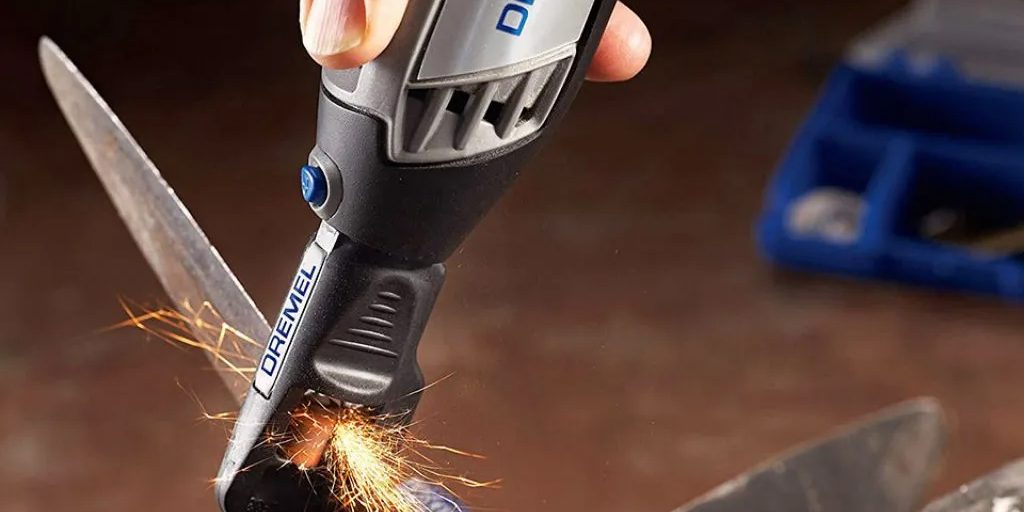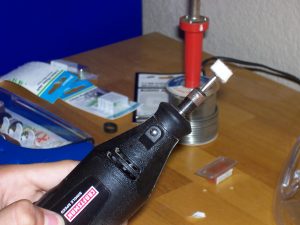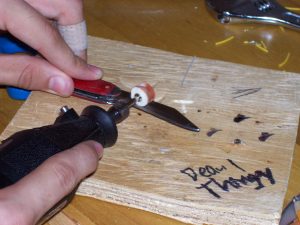If you use your knife daily, it is likely to go dull earlier. Especially, if you utilize the knife for carving and other robust tasks. And not everyone wants to replace their old knives.
So, they tend to look for ways to sharpen knives at home. If you are one of them, you are probably wondering, “Can I use a Dremel to sharpen knives or not.” The answer is “YES!”
However, involving the Dremel to sharpen a dull knife is not an everyday task. So, you might want to know what safety precautions and tools you will really need. Well, to put all your doubts to rest, we are here with our detailed guide to sharpening a knife using a Dremel.
Things Required to Sharpen a Knife with a Dremel
Sharpening a knife with a Dremel is not an easy task due to the size and speed of the Dremel tool. But it is not an impossible task either, especially if you have the tools listed below at hand. And these objects will minimize the risk factors as well –
- Along with a Dremel, you will need Dremel knife sharpening attachments or Dremel bit part No. 932, in other words, an Aluminum oxide grinding stone.
- If you want to polish the knife, get yourself a mandrel, a polishing felt wheel, and a polishing compound (parts no. 401, 414, and 421 respectively). Instead of using a polishing wheel, you can take a nylon bristle brush as well.
- In order to secure and hold the knife in its position, take a vise. Otherwise, the moving knife can injure you.
- Last but not least, to protect your eyes from the flying metal shards, get a pair of safety goggles. You will easily find them in your local hardware stores.
Once you are ready with these objects, get into the sharpening process as discussed in the next section.
How to Sharpen a Knife with a Dremel?
There are several steps involved to sharpen a knife with a Dremel. And you must not skip any steps listed below to make this process efficient and risk-free:
Step 1: Safety Precautions
- First of all, you need to ensure your safety by attaching and placing all the tools and materials in their respective places. For that, you need to install the grinding stone to the Dremel. Look for the hole in the center of the stone, attach the Dremel to the hole and tighten it.
- After that, secure the knife in its position by inserting it into the vise. You need to tighten the vise until you feel the knife blade is well-exposed and secured.
- Cover your eyes with the safety goggles to save yourself from the flying particles of the knife that the Dremel will peel off of the surface.
Step 2: Choose the Correct Angle
- A lot of people do not want to sharpen a knife with a Dremel because they do not know which angle to work with. And to achieve a sharp knife, settling on the right angle with consistency and accuracy is a must. If you want to sharpen one side of the knife at a time, settle at 25 degrees.
- If you are good at handling the Dremel and knife, you can set the knife at 10 to 12.5 degrees angle to sharpen both sides at once. However, we recommend you stick to the 25 degrees mode.
- After sharpening one side of the knife, wait for the blade to cool off.
- Meanwhile, if needed, repeat step 1.
- Now, flip the knife and sharpen the other side by holding the knife at 25 degrees angle.
- Do not forget to start sharpening from the base that is right above the ricasso or handle of the knife.
Step 3: Polish the Blade Right Away
- You can skip this step if you do not want to polish both sides of the knife. Nonetheless, following the step ensures a sparkling knife. So, with a bristle, brush clean the knife to remove the dust particles.
- Then attach the mandrel to the central hole of the polishing felt wheel.
- Take some polishing compounds and rub them on the buffing bit of the mandrel. Slowly, polish the knife with the mandrel.
If you follow all of these steps carefully, you will have a sparkling and sharp knife that looks kind of brand new!
What Are the Tips For Sharpening A Knife With A Dremel?
Handling the Dremel might be a wee bit challenging, especially if you are a newbie. Keeping that mind in factor, we have included some tips that will come in handy to carry out the task –
- If you have never sharpened a knife before, we recommend using a knife that you do not need anymore. Because you can try out the steps with the test knife and note what angle and tools work best for you. After that, you can repeat the whole process with the knife you want to sharpen.
- Do not sharpen one spot for a long time. Otherwise, the rotating Dremel may change the shape of the blade.
Frequently Asked Questions (F.A.Q’s):
- Can a Dremel sharpen any kind of knife?
Dremel is a handy tool to sharpen dull knives. You can easily sharpen kitchen and pocket knives with it. However, using Dremel is not an ideal choice to sharpen a serrated knife. Why? Because the Dremel bit can change the shape of the blade’s edges.
- What Dremel bits are used to sharpen knives?
Dremel bits or attachments such as Aluminum oxide grinding stone, or the Dremel part no. 932 and 952 are the common attachments used for sharpening a knife. And other polishing objects and vises are also essential along with a Dremel.
- Can you sharpen a carving Knife with a Dremel?
Yes, you can sharpen a carving knife with this tool. But you need to be careful enough with the angles. Otherwise, the blade edges can look out of shape.
Conclusion
As Dremel is unforgiving to work with, there can be inconveniences, especially if you do not know how to handle the Dremel. So, in case it is your first time using a Dremel to sharpen a knife, you are likely to ask, “Can I use a Dremel to sharpen knives without involving risks.”
And some online forum members might discourage you to do so. But if you follow our step-by-step guide without skipping anything, this process will not disappoint you!











